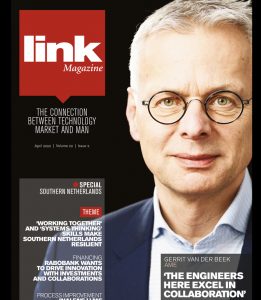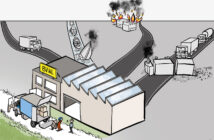The products and subsystems developed by a few large first tiers in the Brainport ecosystem for their end customers are becoming more and more complex – and the time to market needs to be shortened more and more. As a result, multidisciplinary development teams have started to work smarter, almost holistically, with the system architect in one of the leading roles. ‘Without very strong and experienced system architects, you have no business in the high-tech playing field.’

ASML Cleanroon Assembly. Foto ASML
Linchpin in development projects
NTS and Sioux Technologies, two large primary suppliers based in Brainport, devote a great deal of time and energy to recruiting and training technicians who have the skills – and the ambition – to become system architects. Which is a challenge, because not every technician can or wants to become a system architect, says Arend-Jan Beltman, mechatronics manager & technology program manager at Sioux. ‘Most of the technicians are looking for depth in the discipline they graduated in. They prefer to stay far away from the more generalist work, which is fine. These experts are also indispensable in the complex multidisciplinary development projects we carry out.’
Connector
The system architect operates at the intersection of technology and people, says Sander Gielen, who has been working at NTS as group leader of the system architects since 1 February. This department consists of twenty people, mainly mechatronics engineers but also specialists in (opto)electronics, embedded software and optics. He also worked at that intersection in his previous positions at Philips, TNO, PNO and ASML. ‘An important quality of the system architect is their ability to look and think beyond their own discipline (in his case biomechanics, ed.). This overall view enables them to bring together all the disciplines required for a development project.’
Beltman is on the same wavelength. ‘The system architect connects disciplines/competencies on the technical content. This calls for exceptionally good communication skills – and a fair amount of hands-on experience. That is why at Sioux we allow the beginning system architects already to be the project leader’s number two in smaller projects.’
Three in the box
Once they are ready for ‘the big job’, they remain the number two. Beltman talks about ‘three in the box’, referring to the three key resources for each multidisciplinary development project: the project leader, the system architect and the business representative. In order to ensure that the project remains on par with the specs, wishes and expectations of the client, he would like to see them form such a trio too. ‘It increases the chances of success considerably’, he says subtly. After all, the customer pays, and he who pays the piper calls the tune.
‘Without very strong system architects, you have no business in the high-tech playing field’

Ron Willems: ‘The system architect is crucial for us even to be able to develop the complex products and subsystems we focus on.’
That doesn’t mean that the first tier is in the ’your request is our command’ mode, on the contrary. Ron Willems, managing director of Development & Engineering at Sioux, says: ‘Over the years, we have evolved into an integral system partner for our OEM customers and, with more than 400 engineers in Eindhoven, we are one of the largest partners in the region. We can fulfil that role because in areas such as mechatronics, mechanics, electronics, (opto)physics, (embedded) software and – very distinctive – mathematics, we can provide solutions that really help the customer further.’
Outsourcing trend continues
Gielen mentions how the outsourcing trend originated in development projects, first in aviation and automotive and then in the high-tech sector. ‘OEMs were faced with the task of developing and building (sub) systems and equipment that were becoming increasingly complex technically and had to be marketed more quickly. Doing everything in-house was unwise, impractical even. So they started entrusting a first tier with development packages that they did not consider to be core because these no longer had any added value. Whereupon this first tier started investing heavily in increasing its capabilities, making that its core business.’ The result: a handful of large, strong, integral system partners of OEMs, examples being VDL ETG, Sioux Technologies, Frencken Europe and NTS. This trend is continuing and will continue at an increased rate, he ventures to predict, with the interaction with the customer changing.
Time to technology
Rens van den Braber, senior system architect at NTS (with a history at TNO and ASML), agrees. He also sees the role of the development teams on the first tier side gradually changing. Although there are major differences per project and customer. ‘An ASML goes to extremes with long-term planning, has already worked out what the next product should be and by when the customer should have it. You are faced with all kinds of technologies that are not yet mature and as a development partner you must be able to deal not only with time to market, but also with time to technology.’
Difference in dynamics
It is completely different for start-ups and mid-sized manufacturing companies that turn to NTS, says Van den Braber. ‘They typically want to have a system developed to be able to run serial production in, say, six months and expect zero risk because they call in an experienced party. As a system architect – who has to determine the most suitable product and process architecture for the customer and with the customer, ed. – you have a more advisory role in those cases. To give an example: “You ask for serial production, but wouldn’t it be better to first make a prototype and test it on the market, instead of immediately setting up the entire supply chain at the risk of a flop?” It just goes to show that the dynamics differ per customer and per project.’
According to Beltman, this means that the system architect must have excellent communication skills and be able to understand what the customer wants. They must be able to convince that customer – through previous experience and state-of-the-art knowledge of all those new technologies that exist or are in the offing – of what would otherwise be better in their case. They must be able to convey that message about these complex issues in a language that all stakeholders can understand.
Only take on what fits
In brief: the interaction with customers is changing – and in order to manage this satisfactorily, the role of the system architect is becoming more comprehensive and also more decisive for success. Willems is crystal clear about that: ‘The system architect is crucial for us even to be able to develop the complex products and subsystems we focus on. We only take on a new lead if the system architect, together with a very strong multidisciplinary project leader, can indicate which disciplines are needed in the development project.’
Because that much is clear: Sioux and NTS only take on development projects that are up their alley and allow them to prove their added value. Van den Braber says, ‘In the past we sometimes took on projects that didn’t quite fit. We don’t do that anymore. Leads go through a funnel; if they have little or no added value for us, we drop them immediately. Because we really want to focus on where we can make a difference.’
Career
Willems says, ‘Our system architects complete the entire process: from the first customer contact at trade fairs and conferences to delivering the project to assembly. An extremely versatile and challenging job, with plenty of freedom to introduce original and creative solutions that really matter. We can offer people with the relevant skills and ambitions a great career.’ The same goes for NTS.
A strategy that bears fruit: OEMs that want to continue to make rapid progress in areas such as high-precision optics & motion and various other capabilities can no longer disregard those large, strong first tiers. Partly because they have invested heavily, and will continue to do so, in the latest digital design methods and tools. Willems concludes, ‘Without very strong and experienced system architects, you have no business in the high-tech playing field.’

THEME: ‘WORKING TOGETHER’ AND ‘SYSTEMS THINKING’ SKILLS MAKE THE SOUTHERN NETHERLANDS RESILIENT. Read the South Netherlands Special digitally
Strengthening the region together
As a result, these first tier suppliers will gradually find themselves more in the spotlight of OEMs from outside Brainport – a trend that is of course welcome, because it will strengthen the ecosystem in that region.
SysArch: advanced hands-on training
The science and art of purposeful and decisive design and construction of complex multidisciplinary (sub)systems; that is a concise definition of system architecture. Within this framework, the system architect is responsible for translating the requirements of the many stakeholders (including the client, management, production/assembly, potential investor…) into a system architecture blueprint. They do so on the basis of thorough knowledge of the problem domain, the commercial and human context, the resolution domain, technology road maps and relevant, previously developed architectures. The system architect develops the sketch for an integrated design, keeps track, ensures design consistency and provides the context for the development activities carried out by multidisciplinary teams of specialists.
That high acting level is not a given. It requires talent, experience and education/training. SysArch is a course/training programme that has been running successfully for several years within the High Tech Institute in Eindhoven. This institute, which has sprung from Philips Research and the former Philips Centre for Manufacturing Techniques, provides complete training programmes in electronics, mechatronics, optics, software development and leadership.
SysArch is intended for system architects with at least four, five years of hands-on experience. The course provides them with a complete overview of the wide playing field and of the various points of view they have to manage. Short exercises, worked out in small groups, help to see and understand the width of the playing field. The topics covered in the course provide insight into the influence of the organisational structure and the importance of focusing not only on technical, but also on business, process and human aspects. The course simulates what a system architect is constantly doing in their head: very quickly reviewing multiple points of view. To this end, SysArch provides tools to tackle architectural problems, such as how to balance the many, often conflicting requirements and how to set up a road map and the basis for a business case.






